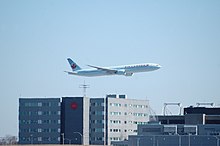Saint-Laurent (Montreal)
| Saint-Laurent | |
|---|---|

|
|
| city | Montreal |
| surface | 42.8 km² |
| Residents | 93,842 (2011) |
| native language |
French : 29.8% English : 15.5% Other: 54.7% |
| Community number | REM15 |
| Website | Arrondissement |
Saint-Laurent is one of the 19 arrondissements of the city of Montreal in the Canadian province of Québec . Before 2002 it was a separate municipality. In 2011 the 42.8 km² district had 93,842 inhabitants. The raw materials group 5N Plus is based in Saint-Laurent.
geography
Saint-Laurent is roughly in the center of the Île de Montréal and is socio-geographically part of the West Iceland region . Neighboring arrondissements of the city of Montreal are Pierrefonds-Roxboro in the north-west, Ahuntsic-Cartierville in the north, Côte-des-Neiges-Notre-Dame-de-Grâce in the east and Lachine in the south. In addition, Saint-Laurent borders the following independent municipalities: Dollard-Des Ormeaux in the west, Dorval in the south-west, Côte-Saint-Luc in the south-east and Mont-Royal in the north-west. About half of the district area consists of industrial and commercial zones. There is also a freight yard and part of Montreal Airport .
history
The first colonists settled here in 1700 after the Sulpizian order released the area for settlement. In 1720 the parish of Saint-Laurent was established, named after Saint Lawrence of Rome . In 1845 the municipality of Saint-Laurent was founded, which was granted city rights in 1893. In 1912 Mont-Royal split off, in 1964 Notre-Dame-de-Liesse was incorporated.
The Congregation of the Holy Cross established its Canadian headquarters in Saint-Laurent in 1847, which contributed to the further growth of the place. After the opening of a railway line in 1885, numerous industrial companies settled there. In 1918, Cartierville Airport opened in the west of the city and was in operation for seven decades. During World War II, Saint-Laurent became the center of Canada's aviation industry, with companies such as Vickers , Canadair and Bombardier Aerospace . As a result, the city experienced an enormous economic boom; Industrial and commercial enterprises completely displaced the previously predominant agriculture. In 1956 the national film production company, the National Film Board of Canada , relocated its headquarters here, and in 1992 the airline Air Canada too .
On January 1, 2002, Saint-Laurent merged with Montreal and has since formed an arrondissement. A referendum was held against the merger ordered by the provincial government. Although a majority voted in favor of detachment on June 20, 2004, the required quorum (approval of 35% of all voters) was not achieved.
population
According to the 2011 census, Saint-Laurent had 93,842 inhabitants, which corresponds to a population density of 2193 inhabitants / km². Of the respondents, 29.8% said French and 15.5% English were their mother tongue. Other important languages include Arabic (14.8%), Chinese (7.5%), Spanish (4.2%), Greek (3.8%), Vietnamese (2.2%), Armenian (2, 0%) and Italian (2.0%). Saint-Laurent is therefore very multicultural.
Personalities
- Mathieu Darche (* 1976), ice hockey player
Attractions
Web links
- Website of the Arrondissement of Saint-Laurent (French)
- History of Saint-Laurent (French)
Individual evidence
- ↑ Saint-Laurent. Commission de toponymie Québec, accessed September 2, 2011 (French).
- ↑ Référendums du 20 juin 2004. Directeur général des élections du Québec, accessed on September 2, 2011 (French).
- ↑ Annuaire statistique de l'agglomération de Montréal, recensement de 2011. (PDF, 728 kB) City Council of Montreal, Statistics Canada, 2011, accessed on February 25, 2014 (French, Statistical Yearbook of the Agglomeration of Montreal 2011).
Coordinates: 45 ° 30 ′ 58 " N , 73 ° 40 ′ 48" W.

